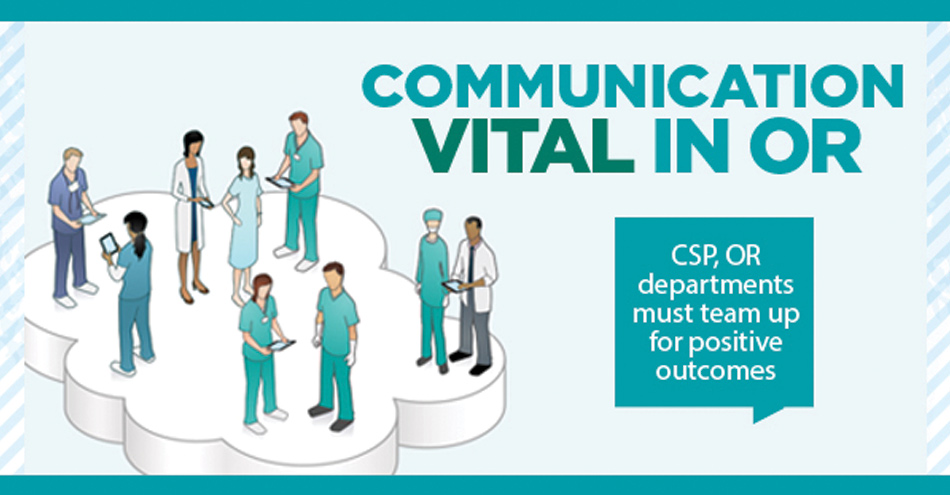Communication Vital in OR: CSP, OR Departments Must Team Up for Positive Outcomes
by Don Sadler
There’s no question that the central sterile processing (CSP) department plays a vital role in the achievement of positive surgical outcomes for patients. OR personnel rely on CSP to provide the clean, sterilized instruments they need for surgical procedures — when they need them. This makes it vital that there be a healthy relationship between individuals in the CSP and OR departments.
Such a relationship starts with open and honest communication between OR and CSP personnel. “The two departments need to form and nurture a communication program that allows for everyone to communicate honestly, without demeaning others or pointing fingers,” says Patti Koncur, educational specialist with the International Association of Healthcare Central Service Materiel Management (IAHCSMM). “A good communication system will allow the departments to work together to find the cause of any problems or concerns and solutions that will work effectively for both departments.”
A Common Goal
 The first step in making the communication process go more smoothly is to acknowledge that both groups have the same goal: to care for the patient. “It is never an ‘us against them’ situation,” says Natalie Lind, educational director for IAHCSMM. “Rather, it is an ‘all of us for the patient’ situation.”
The first step in making the communication process go more smoothly is to acknowledge that both groups have the same goal: to care for the patient. “It is never an ‘us against them’ situation,” says Natalie Lind, educational director for IAHCSMM. “Rather, it is an ‘all of us for the patient’ situation.”
Ramona Conner, MSN, RN, CNOR, manager, Standards and Recommended Practices for the Association of periOperative Registered Nurses (AORN), concurs: “Everyone has a common goal: to ensure that fully functioning sterile devices are received at the point of use in the OR when they are needed. To accomplish this, communication between OR and CSP personnel has to be ongoing. They have to be aware of the unique challenges faced by each other.”
Many perioperative nurses aren’t aware of the complexities of sterilizing and decontaminating surgical instruments, Conner adds. “This is especially true when it comes to sensitive and intricate instruments like robotic devices. Instruments like these weren’t around when many of us were trained,” she says. “As medical technology continues to evolve and more complex, heat-sensitive instruments are introduced, instrument sterilization will grow even more complex.”
Koncur says that meeting each other in person and in the different departments helps both sides see the entire operation and the challenges faced on a daily basis. “Working together to form solutions when all the challenges are known makes for an effective partnership,” she adds.
Lind suggests that OR and CSP personnel set aside some time when there are no immediate needs and discuss the actual processes, as well as why specific processes are followed.
“Keep an open mind and listen to each other’s ideas. Developing understanding and a spirit of respect and cooperation can go a long way in strengthening the relationship,” Lind says.
Conner says she has worked at facilities where there was healthy interaction and communication between the OR and CSP departments, with strong collaboration and cooperation, and at facilities where the interaction was less healthy.
“Since we’re all human, there are bound to be conflicts at times,” she says. “These should always be resolved through direct, face-to-face communication. There’s no substitute for personal observation of what each other is doing on their turf to raise awareness of the challenges staff in each department face.”
When there is strong communication and a healthy relationship between the OR and CSP departments, each side can better respond to changing instrument needs, says Koncur. “For example, when CSP is aware of changing instrumentation needs in the OR due to add-on cases, cancellations, trauma, etc., they can better respond to these needs,” she adds. “And when OR personnel are informed in advance about instrumentation issues in CSP, they may be able to substitute instruments, change schedule order, or compensate in some other way to allow the case or the day to run smoothly.”
Trends in Sterilization
According to Conner, one of the biggest trends in instrument sterilization is the shift away from flash sterilization to immediate use steam sterilization. This has been enabled by the introduction of new rigid instrument containers that are designed for abbreviated steam cycles, she explains.
“There is still a lot of confusion about the differences between flash sterilization and immediate use steam sterilization,” says Conner. “With flash sterilization, surgical instruments are placed into the sterilizer on an open tray. The drying cycle is abbreviated or eliminated so instruments are delivered to the point of use on an open tray, wet and hot. This makes it hard to ensure that instruments are not contaminated before reaching the point of use.
“With immediate use steam sterilization, surgical instruments are placed in a rigid container that’s validated for abbreviated sterilization cycles,” Conner adds. “This protects them from contamination during transport to the point of use.”
Janet Pate, JD, MHA, BSN, RN, director, Environment of Care and Employee Health at The Kirklin Clinic at the University of Alabama Health Services Foundation, also stresses the importance of safe transport of instruments from CSP to the OR.
“Surgical instruments should always be transported to the OR in closed, puncture-resistant containers for safety purposes,” Pate says.
“Ideally, instruments should be sent to the OR and received with only enough time to prepare for the case,” Koncur adds. “Sending instruments up the day, or even many hours, before they are needed reduces the flexibility for both departments to respond to the changing needs of the day.”
Perioperative nurses should also be educated on the pre-cleaning steps they should take while dirty instruments are still in their hands to help CSP personnel do their job more effectively, Pate says. This includes the use of sterile water and instrument transport humectant pre-cleaners to help prevent the adhesion of bio-film and bio-burden on surgical instruments before they are transported back to CSP.
“The pre-cleaning process is critical to disinfection and sterilization, because you can’t sterilize bloody instruments. It gets the cleaning process started immediately, because the sooner breakdown occurs, the better. These pre-cleaners break down proteins and enzymes in blood and body fluid to better prepare the instruments for CSP, which receives a cleaner instrument before sterilization even starts.”
For example, Prepzyme® Forever Wet Spray from Ruhof is an enzymatic pre-cleaning spray that helps prevent bio-burden from drying on the surface of instruments and scopes. It gently coats soiled instruments and scopes to maintain moisture for up to 72 hours.
There is no single cleaning, inspection or sterilization process that works for every instrument.
“CSP professionals must be familiar with the manufacturer’s Instructions for Use (IFUs) for each instrument, and staff must follow those recommendations for each instrument,” Lind says.
Robotic instruments, in particular, pose special reprocessing challenges, she adds.
“Proper cleaning of robotic instruments requires a knowledgeable technician and the time and tools necessary to do the job correctly,” Lind adds. “As with all instruments, robotic instruments must be reprocessed in accordance with the manufacturer’s IFUs.”
On the Same Page
IAHCSMM President Sharon Greene-Golden, CRCST, FCS, stresses that improving the relationship between CSP and OR personnel takes an understanding by everyone that they are all working together for the good of the patient.
“Both teams need to understand that we need each other in order to function as a well-oiled machine,” Greene-Golden says. ‘”We must get on the same page and work together with respect and integrity for the jobs we all do daily. In the end, our patients win — and positive working relationships are formed out of the need to provide great service to the patient.”











